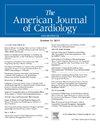A Combined Electrocardiographic and Imaging Predictive Risk Model for New Permanent Pacemaker After Transcatheter Aortic Valve Implantation: The RITMO Score
IF 2.3
3区 医学
Q2 CARDIAC & CARDIOVASCULAR SYSTEMS
引用次数: 0
Abstract
Currently, permanent pacemaker implantation (PPMI) is the most common complication of transcatheter aortic valve implantation (TAVI). The aim of this analysis is to develop a simple and effective risk prediction model for PPMI within 30 days of TAVI. Data from 370 patients who underwent TAVI with the self-expanding valve between February 2015 and June 2022 at our center were collected in the development cohort (DC). A risk score was developed based on baseline anatomical and electrocardiographic characteristics, including the estimation of aortic calcium load (ACL) using both the Agatston score and calcium volume. A validation cohort (VC) of 234 patients was used to test the score. Seventy-two patients (19.5%) underwent PPMI in DC. Preprocedural right bundle branch block (RBBB), membranous septum length (MSL) <5 mm, and severe ACL were significant predictors of PPMI. The Agatston score showed higher agreement with PPMI compared to calcium volume (K = 0.89; 95% CI 0.84 to 0.93 vs K = 0.71; 95% CI 0.64 to 0.79, respectively). Pre-existing RBBB, MSL, and Agatston score have been combined into a simple score, called RITMO (theoretical range from −1 to 4 points). We applied the score to the VC and find that a high score (>1) had an OR>6 to predict PPMI after TAVI. In patients undergoing TAVI with a self-expanding valve, baseline RBBB, shorter MSL, and higher ACL evaluated using the Agatston method were predictive of 30-day PPMI. In conclusion, the RITMO score represents a simple tool for risk stratification, with implications for procedural planning and patient counseling.
经导管主动脉瓣置入术后新型永久性起搏器的综合心电图和影像学预测风险模型:RITMO评分。
目的:目前,永久性起搏器植入术(PPMI)是经导管主动脉瓣植入术(TAVI)最常见的并发症。本分析的目的是建立一个简单有效的TAVI后30天内PPMI风险预测模型。方法:从2015年2月至2022年6月在我们中心接受TAVI的370例患者的数据收集到发展队列(DC)中。风险评分基于基线解剖和心电图特征,包括使用Agatston评分和钙容量估计主动脉钙负荷(ACL)。采用234例患者的验证队列(VC)对评分进行检验。结果:DC行PPMI 72例(19.5%)。术前右束支阻滞(RBBB)、膜间隔长度(MSL) 1预测TAVI后PPMI的OR值为bbb6。结论:在接受TAVI的自扩张瓣膜患者中,基线RBBB、较短的MSL和使用Agatston方法评估的较高ACL可预测30天PPMI。总之,RITMO评分是一种简单的风险分层工具,对程序规划和患者咨询具有指导意义。
本文章由计算机程序翻译,如有差异,请以英文原文为准。
求助全文
约1分钟内获得全文
求助全文
来源期刊

American Journal of Cardiology
医学-心血管系统
CiteScore
4.00
自引率
3.60%
发文量
698
审稿时长
33 days
期刊介绍:
Published 24 times a year, The American Journal of Cardiology® is an independent journal designed for cardiovascular disease specialists and internists with a subspecialty in cardiology throughout the world. AJC is an independent, scientific, peer-reviewed journal of original articles that focus on the practical, clinical approach to the diagnosis and treatment of cardiovascular disease. AJC has one of the fastest acceptance to publication times in Cardiology. Features report on systemic hypertension, methodology, drugs, pacing, arrhythmia, preventive cardiology, congestive heart failure, valvular heart disease, congenital heart disease, and cardiomyopathy. Also included are editorials, readers'' comments, and symposia.
 求助内容:
求助内容: 应助结果提醒方式:
应助结果提醒方式:


